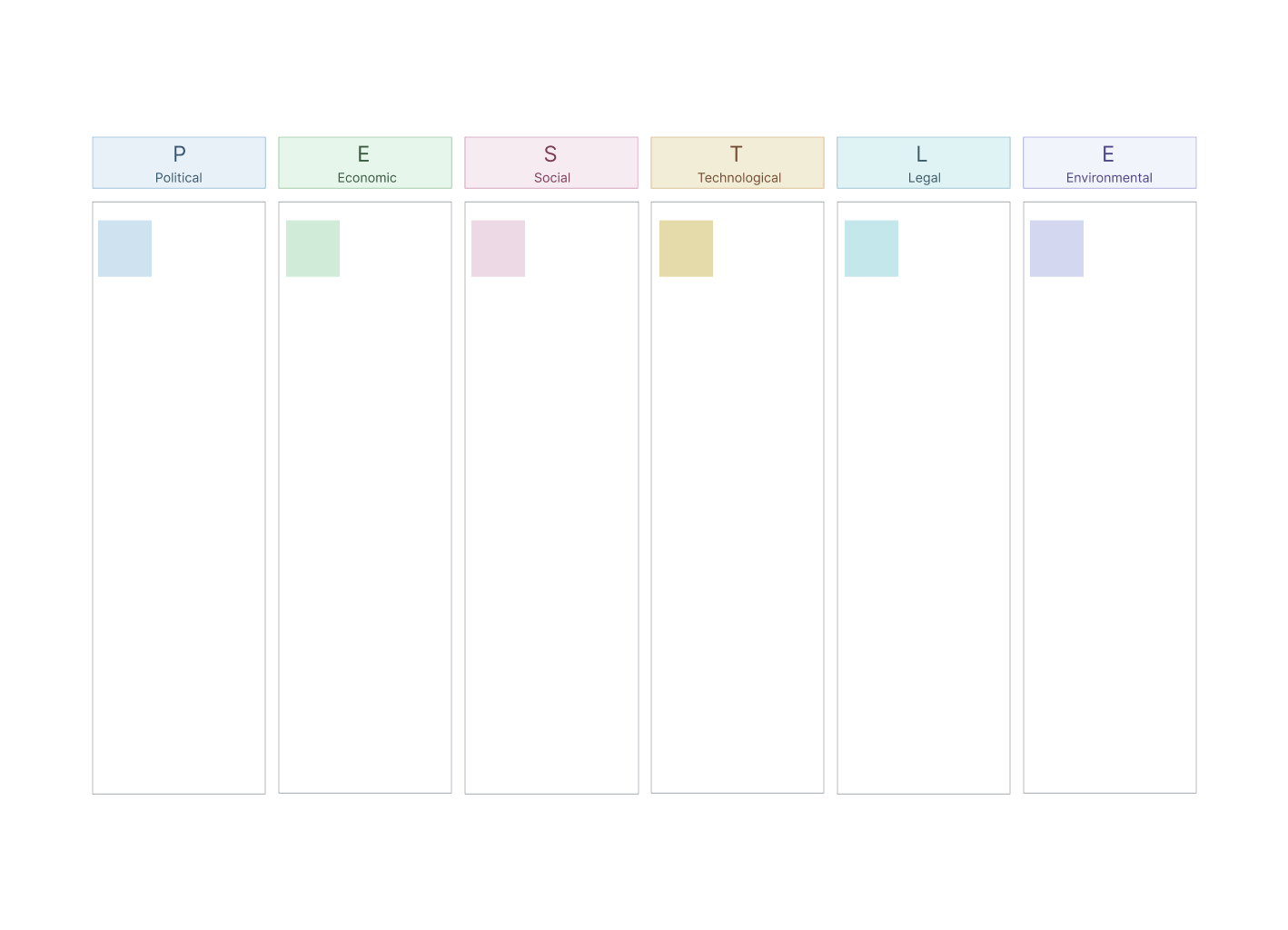A PESTLE analysis helps you understand the external factors—Political, Economic, Social, Technological, Legal, and Environmental—that can influence your business or project.
Looking at real PESTLE analysis examples makes it easier to see how these factors actually play out in different industries. In this guide, we’ve put together real-world PESTEL analysis examples from leading global brands across industries to help you better apply the framework in your own work.
1. Starbucks PESTLE Analysis Example
Starbucks is affected by changing coffee prices, global trade policies, and climate conditions. It also has to keep up with health trends and customer demand for ethical and eco-friendly products. See how these factors shape everything from how it sources ingredients to how it designs its stores.
2. PESTLE Analysis Example of Sony
Sony operates across tech, gaming, and entertainment, so it faces many regulations around copyrights and digital content. Currency shifts and rising costs affect its pricing. At the same time, changes in how people consume media—like streaming over traditional formats—force Sony to keep evolving.
3. PESTLE Analysis Example for Apple Inc.
Apple’s global success means it has to deal with trade tensions, manufacturing rules, and data privacy laws in many countries. It leads in technology, but also faces pressure to improve how its products are made—especially when it comes to labor practices and environmental impact.
4. PESTEL Analysis Example of Tesla
Tesla’s business depends heavily on government policies that support electric vehicles and clean energy. It also faces rising costs for materials and manufacturing. On the social side, customers expect Tesla to lead in innovation while staying true to its mission of reducing environmental impact.
5. Coca-Cola PESTLE Analysis Example
Coca-Cola has to respond to sugar taxes, changing health regulations, and new labeling laws in many markets. Shifting consumer preferences toward healthier drinks are pushing Coca-Cola to expand its product range. Environmental concerns around water use and plastic waste are also key challenges.
6. Nike PESTEL Analysis Example
Nike works across a complex global supply chain and must follow international labor and trade rules. Social movements call for more diversity and sustainability, pushing Nike to focus on fair labor and eco-friendly materials. Fashion trends and tech innovation also shape its product strategy.
7. Samsung PESTEL Analysis Example
Samsung is a global tech giant influenced by trade policies, patent laws, and fast-changing technology trends. It also faces competition from new brands and needs to meet growing demand for sustainable and energy-efficient products.
8. Uber PESTLE Analysis
Uber often finds itself in legal battles over how drivers are classified and where it’s allowed to operate. Rising fuel prices and safety concerns also play a big role in its business. To stay ahead, Uber keeps investing in technology like ride tracking, automation, and delivery services.
9. Disney PESTEL Analysis
Disney has to follow different rules in each country when it comes to content and media. It also needs to keep up with how people are watching content—mostly on streaming platforms now. Technology helps it create better content, but it also brings more competition.
10. Adidas PESTLE Analysis
Adidas faces rising pressure to be more sustainable, from both customers and governments. Fashion changes fast, and Adidas needs to keep up while maintaining fair working conditions. It also invests in technology to improve how products are made and sold online.
How to Use Creately’s AI PESTLE Analysis Example
With AI support and editable templates, Creately makes it simple to go from example to your own customized, collaborative PESTLE analysis—without starting from scratch. Here’s how to do a PESTLE analysis with Creately.
Step 1 — Set up your workspace and scope
Open the AI PESTLE template in Creately and give your canvas a clear title. Define the scope, such as market, product, timeframe, and team. The template already has sections for Political, Economic, Social, Technological, Legal, and Environmental factors, so you can start quickly.
Step 2 — Feed AI with context and research
Provide details about your business, objectives, and any research notes or documents. The AI will generate factor suggestions tailored to your context. Review the suggestions carefully, refine vague points, and attach evidence directly to each factor.
Step 3 — Collaborate and brainstorm
Invite your team to the canvas to add ideas, comment, or vote on factors. Everyone can see live updates, use reactions, and tag team members. This makes the analysis more thorough and collaborative.
Step 4 — Organize and prioritize
Group similar factors, label them as Opportunity, Risk, or Watch, and summarize key insights at the top of each section. Use Creately’s prioritization matrix to score factors by impact and likelihood to focus on the most critical issues.
Step 5 — Turn insights into actions and share
Convert top factors into actionable tasks, assign owners, set deadlines, and link tasks to the original factor. Use Kanban or Timeline views to track progress. Present the analysis in Creately’s presentation mode, save versions, and clone the canvas for future projects.
FAQs About PESTEL Examples
What is a PESTLE analysis used for?
When should I conduct a PESTLE analysis?
What are common mistakes to avoid in a PESTLE analysis?
What comes after a PESTEL analysis?
What’s the best way to create my own PESTLE analysis based on an example?







